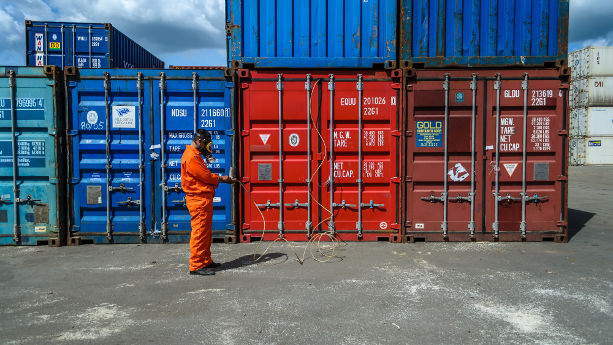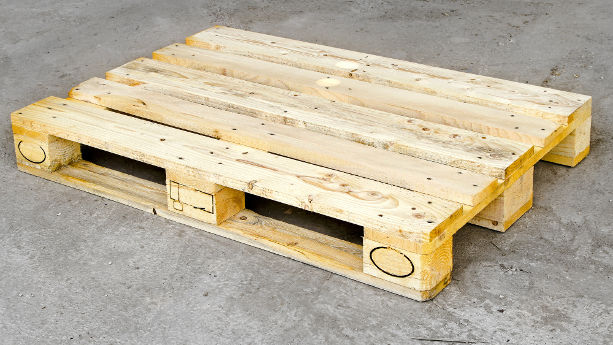
EU Importers are responsible to ensure that their wood packaging materials like pallets, skids, containers, cases, and dunnages, and other plant products, are not infested with pests or parasites that could cause ecological damage to the local environment
In this article, we introduce EU regulations and international pest control standards, such as ISPM 15, for wooden products, such as wood packaging materials.
Content Overview

FREE CONSULTATION CALL (US, EU & UK)
- Request a free 30-minute call with Ivan Malloci to learn how we can help you with:
- Find product requirements
- Certification and labeling
- Lab testing
What is fumigation?
Fumigation is a chemical treatment that completely fills an area, such as a container or a tent, with gaseous pesticides or fumigants to exterminate the parasites and pests hidden inside the wood.
Wooden products, including wood packaging materials, might contain parasites, pests, and other microorganisms that might become invasive species in the ecosystems of the countries where the products are imported to.
For this reason, most countries require certain types of imported plant products, including wood packaging materials, to undergo proper pest control measures, such as fumigation.
What is heat treatment?
Heat treatment aims at killing the parasites by applying high temperatures to the products, instead of using chemicals as in the case of fumigation. Therefore this method creates less of an adverse impact on the environment. The most common heat treatments include:
- Conventional steam heating
- Kiln-drying
- Heat-enabled chemical pressure impregnation
- Dielectric heating treatment
As an example, conventional steam or dry kiln heating treatment requires the minimum temperature during the heating process to be at least 56 °C, with every part of the wood packaging materials to be heated for at least 30 minutes.
Pests and parasites are killed off when the wood products are heat treated. At the same time, the nutrients in the wood are lost, which makes it difficult for pests and fungi to develop and grow.
In addition, heat-treated wood products are porous and contain less fluid, which could improve the insulation ability by 25-30 percent, according to a study by a forest owner association from Sweden.

For which products is fumigation or heat treatment required in the EU?
The EU might require phytosanitary measures, such as fumigation or heat treatment, for plant products that have not undergone any process such as glue, heating, or pressure. Plant products are defined as either unmanufactured wood products or manufactured products that might cause a risk of spreading pest, including:
a. Products that retained part of their natural round surface, or lost it after undergoing sawing, cutting, or cleaving
b. Chips, particles, sawdust, wood waste, and similar products
c. Wood packaging products thicker than 6 mm
In particular, the following wood packaging products might require fumigation or heat treatment:
- Pallets
- Skids
- Containers
- Crates
- Boxes
- Cases
- Bins
- Reels
- Dunnages
For which products is fumigation or heat treatment not required in the EU?
Fumigation or heat treatment is required only for some categories of plant products. Some products, due to their shape or treatments, are considered free of pests, including:
a. Products made from wood that thinner than 6 mm
b. Products that have been treated with glue, heat, or pressure (i.e. pellet, plywood, particleboard, oriented strand board)
c. Wine or spirit barrels, gift boxes, or cigars cases, that have been specially treated to prevent pests
Fumigation or Heat Treatment Requirements: Regulation (EU) 2016/2031
Regulation (EU) 2016/2031 sets up requirements for the determination of the phytosanitary risks posed by any species of pathogenic agents, animals, or parasitic plants that are harmful to plants and plant products.
At the same time, the regulation includes measures such as fumigation or heat treatment, to mitigate the damages caused by these species to an acceptable level, when importing plant products that might contain any of them.
More specifically, the following “plant products” need to undergo treatment before importation into the EU:
a. Wooden packaging products thicker than 6 mm, that were not treated with glue, heat, or pressure, must be treated according to the ISPM 15 procedures (fumigation or heat treatment, and marking)
b. Other types of untreated wooden products, such as products that retained part of their natural round surface, must undergo similar treatment but shall not be marked according to ISPM 15
ISPM 15: Heat Treatment and Fumigation for wooden packaging products
ISPM 15 stands for International Standards For Phytosanitary Measures No. 15. This standard was developed by the International Plant Protection Convention (IPPC) in order to reduce the spread of quarantine pests in wood packaging materials due to international trading.
Currently, more than 180 countries adopt ISPM 15, including all the member countries of the European Union.
ISPM 15 covers wood packaging materials such as:
- Pallets
- Skids
- Containers
- Crates
- Boxes
- Cases
- Bins
- Reels
- Dunnages
Debarkment
ISPM 15 requires that wood packaging materials must be made of debarked woods. There are only two exceptions for packaging containing small and separate pieces of bark:
a. Each piece of bark measures less than 3 cm in width, or
b. Each piece of bark has an area lower than 50 square cm
Fumigation
ISPM 15 approves two types of fumigation:
a. Methyl bromide treatment (treatment code: MB)
b. Sulfuryl fluoride fumigation (treatment code: SF)
Note that fumigation is not accepted for pieces of wood that have a cross-section thicker than 20 cm at its smallest dimension.
Also, sulfuryl fluoride treatment is not accepted for wood products with a moisture content higher than 75%.
Finally, the IPPC discourages the use of methyl bromide treatment due to its negative impact on the environment. The substance is also banned in the EU, except for emergency quarantines.
Heat treatment
ISPM 15 accepts four different types of heat treatment:
a. Conventional steam heating (treatment code: HT)
b . Dry kiln heating (treatment code: HT)
c. Microwave treatment (treatment code: DH)
d. Radio-frequency treatment (treatment code: DH)
The first two methods require the entire profile of the wood to reach a minimum temperature of 56 °C for a minimum of 30 minutes (continuously).
The last two methods, which are also called “dielectric heating treatments”, use microwaves or radio waves. In this case, the wood shall reach a minimum temperature of 60 °C for a minimum of 1 minute (continuously).
Note that treatment providers shall be authorized by the National Plant Protection Organization (NPPO) of the exporting country. Thus, importers are advised to contact the NPPO of the exporting country to gather more information (link).
ISPM 15: IPPC Mark
ISPM 15 requires that all wood packaging materials under the scope of its supervision and control shall be labeled with the IPPC Mark. The IPPC mark indicates that the products have been treated accordingly to approved phytosanitary treatments, and shall include the following information:
a. The IPPC certification symbol
b. The ISO country code where the fumigation or heat treatment procedure was performed (e.g. AU for Australia, US for the United States, GB for the United Kingdom)
c. A unique code assigned to treatment providers, to ensure traceability
d. The treatment code (HT, DH, MB, or SF, as described in the previous section)
Also, the IPPC Mark must be:
- Clearly legible
- Durable
- Visible in the exterior part of the packaging
- Preferably applied to at least 2 sides of the packaging
Finally, note that according to ISPM 15, a phytosanitary certificate for regulated wood packaging products is “unnecessary”, since the application of the IPPC Mark is a clear indication of the product compliance to the requirements by the ISPM 15, and thus replaces the certificate.
National Plant Protection Organizations
Both the treatment supervision and the application of the Mark are under the authority of National Plant Protection Organizations (NPPOs) of the exporting country.
In particular, NPPPs shall:
a. Authorize treatment providers
b. Supervise the treatment procedure carried out by authorized treatment providers
c. Authorize the use of the IPPC Mark on treated wood packaging material
d. Establish inspection and auditing procedures, when appropriate
Phytosanitary Certificate
A phytosanitary certificate might be necessary for some categories of plant products, including:
a. Products that have been partially treated but are still deemed capable of being infested – for instance, because additional processing is planned after the importation into the EU
b. Some types of plant products, even if when treated with either fumigation or heat treatment
b. Plants, seeds, and similar products
The certificate shall fulfill the following characteristics:
a. It shall be addressed to the NPPO of a Member State
b. It shall be issued a maximum of 14 days before the exportation of the products
c. It shall include the name and address of the importer, the place of origin, and the treatment (if any)
As already said, wooden packaging products that have been treated and marked according to ISPM 15, don’t need a phytosanitary certificate.
What happens if my products are non-compliant?
If plant products, including wood packaging materials, do not meet the standards specified by Regulation (EU) 2016/2031, the authorities have the right to execute one or more of the following measures:
- Refuse consignment entry into the EU
- Remove infested consignment from the EU
- Destroy the consignment
- Impose a quarantine until test results are completed and available
Fumigation treatment services
Importers of consignments that contain regulated plant products or wood packaging materials can contact reputable agencies to learn how to conduct appropriate fumigation or other relevant treatments, and obtain the necessary documentation to comply with the EU requirements.
Here two companies that offer such services:


















